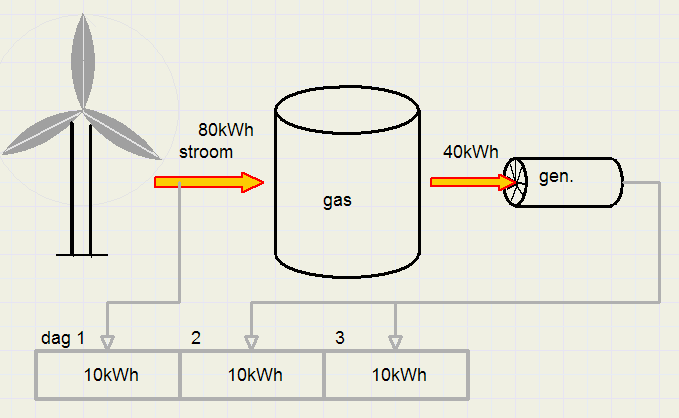

| Green Lies the windfarm fallacy |
Newspaper article
"...The new -Gemini- windfarm, largest in the Netherlands, will count 150 windmills of 4MWatt capacity each.The project costs 3 billion euro's and will provide 785.000 households of electrical energy."
Lie 1
The Gemini windfarm will provide exactly zero energy to housholds on calm days.Modern societies need electrical energy around the clock, so standby power stations are necessary.
Less dependency on fossile fuels is out of the question.
Lie 2
In energy calculations on windmills, the so called "production factor" is used.This is the average energy production divided by the peak energy.
For windfarms at sea, a realistic figure is 33%.
It means, that for every day of sufficient wind there are two days without wind.
A (Dutch) household needs about 10kWh electrical energy per day.
The Gemini windfarm average daily production is 0,33 * 150 * 4Mwatt * 24 = 4,752GWh.
So, energy is supplied to (4,752 * 109) : (10 * 103) = 475200 households.
Lie 3
The number before is rather optimistic.First we recall, that calculation of averages must imply addition.
Without addition, no average can be calculated.
The energy of a windmill must be added, which means : stored for later use.
In this storage- and unloading process, energy is lost.
Realism
Let's observe a reliable energy system.Pumped storage is the cheapest and most efficient storage system.
However, for the Netherlands and other flat and overcrowded countries this is no option.
Gas storage is.(but research is necessary, there are no working mass storage systems yet)
Electrical energy from the windfarm is used for the electrolyse of water (H2O) into hydroxen (H2) and oxygen.
Hydroxen is nasty to handle, therefore using carbondioxide (CO2) we produce methane gas (CH4).
The efficiency of this process of current to methane is about 50%.
Burning CH4 to power generators for electricity production again has an efficiency of 50%.
Total efficiency of current --> gas --> current is 25%.
24 / 7 Reliable energy

Day 1 has strong wind and the farm directly powers households.
Also that day, gas must be produced for calm days 2 and 3.
20kWh current needs 80kWh energy for the gas production.
The windfarm must deliver 90kWh per household on a windy day.
So, in reality (600*106*24) : (90*103) = 160.000 households may be powered.
Lie 4
Counting only electricity and households is complete nonsense.Households do not survive on electrical current alone, but need agriculture, industry, transportation and heating.
The Netherlands uses 3TWh (3 + 12 zero's ) energy daily.
Let that be 2TWh as a result of smart reduction programs.
The Netherlands counts 7 million households.
So, the national daily energy consumption is about 300KWh per household.
Say this energy is delivered as 100kWh electrical- and 200kWh as chemical (gas) energy.
How many "households" would the Gemini windfarm serve?

The Gemini windfarm, 65 square kilometers, serves no more than (600*106*24) : (2100*103) = 6900 households.
One village only.
Costs per household are 420.000 euro's.
Depreciation in 20 years (optimistically) yields a yearly cost of 20.000 euro's per household.
Still uncounted are the costs of the gas production and the windfarm to grid connection,
the latter be around one billion.
But at least it works.
Notes:
1.The green believers are overwhelmed by emotion and ignorance and forget to realise that mankind is
subject to the laws of physics.
2. For the money of a windfarm a nuclear power plant can be built providing a constant and reliable 1,5GWatt electrical power.
The same as 10 Gemini windfarms, but covering an area of less than one-thousandth.
3. The green world is a world of fraud, see:
Apple runs 100% on renewables?

